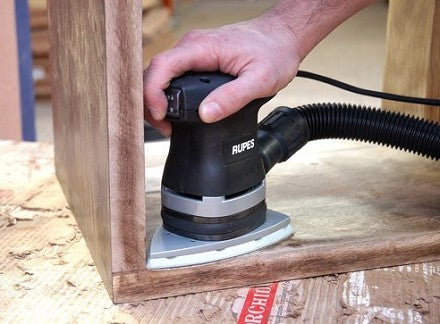What Sander Should I Use? - Detail Sanders
When choosing a sander there are a lot more factors to consider than brand and price. These will include shape, size, power, orbital or random orbital, orbit size, variable speed, dust extraction but most importantly its intended purpose.
To help with choosing your sander I will break it down into several factors, the first being the shape or style of the sander. There are many shapes available including round, square, rectangular etc and they all serve different functions. Too often a sander is purchased based on the perceived benefit of that shape, rather than its practical application.

Today we dig deeper into Triangle or Delta Sanders:
Delta sanders are one of the most common sanders purchased, yet in reality they should not be as they are a small finishing or detailing sander not inherently designed for heavier work.
The delta sander was originally designed for using in tight spaces like between balustrades, inside cabinetry and unusual profiles, not as a primary general all-round sander. Although there have been modifications to improve the efficiencies of detail sanders over the years, there has not been a change in its original purpose.
The Shape
The Delta detail sanders come in a variety of shapes and sizes depending on the brand. These include triangle, mouse, corner, prio and iron shapes.
When using a detail sander you need to use the whole abrasive to maximise the effectiveness of the tool.
Tip: As the detail end of the sanding sheet usually wears out first, some sanding sheets are manufactured in two parts - enabling this section to be replaced without having to throw the whole sheet away.

Power (Watts)
Detailing sanders are small and compact in design, to maintain this they have much smaller motors powering them. The typical power range varies between 175W and 250W,
Orbit
Designed for finishing work, Delta sanders will always have a small orbit. This allows for precision sanding, and limits damaging adjacent surfaces when working in confined and tight spaces. At Millin we stock Delta sanders ranging from the Metabo FMS 200 with a 1.4mm orbit, to the Mirka Deos Delta with a 3.0mm orbit.
Orbital sanders aren’t overly aggressive, so it’s time consuming to remove large amounts of material even when using coarser grits.
Variable Speed
Usually found on premium models like the Rupes LS71TE, Variable Speed allows for increased control and precision in detailed sanding.

Pad Savers And Dust Extraction
Usually smaller sanders are supplied with a passive dust bag or catcher, however with all sanders you should attach to an active dust extraction system. There are multiple benefits of doing this including reducing labour and consumable costs, a much cleaner workspace, as well as better for you and the environment.
Tip: Pad savers are a sacrificial pad that extends the life of the main backing pad and far cheaper than replacing backing pads.
Click here to learn more about Pad Savers and Dust Extraction
Advantages Of A Delta Sander
Compact size, light weight, perfect for tight, confined areas and for doing finishing and detailing work. Although able to use with coarse grits I recommend detail sanders be used with 80gt and finer.
Disadvantages Of A Delta Sander
Too much sanding is done with the ends, neglecting the main body of abrasive. The Delta Sander can be slow if using for heavier sanding or removing multiple layers.
Click Here To see our range of Delta Sanders
Happy Sanding!
If you have any questions please get in touch Ask Matt

